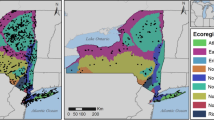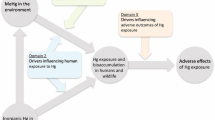Abstract
Ecological risk assessments for mercury (Hg) require measured and modeled information on exposure and effects. While most of this special issue focuses on the former, i.e., distribution and fate of Hg within aquatic food webs, this paper describes an approach to predict the effects of dietary methylmercury (CH3Hg) on populations of piscivorous birds. To demonstrate this approach, the U.S. Environmental Protection Agency’s National Health and Environmental Effects Research Laboratory (U.S. EPA NHEERL) is working cooperatively with environmental and conservation organizations to develop models to predict CH3Hg effects on populations of the common loon, Gavia immer. Specifically, a biologically-based toxicokinetic model is being used to extrapolate CH3Hg effects on the reproduction of a tested bird species, the American kestrel (Falco sparverius), to the loon. Population models are being used to incorporate stressor effects on survival and reproduction into projections of loon population effects. Finally, habitat and spatially-explicit population models are being used to project results spatially, assess the relative importance of CH3Hg and non-chemical stressors, and produce testable predictions of the effects of biologically-available Hg on loon populations. This stepwise process provides an integrated approach to estimate the impact on wildlife populations of regulations that limit atmospherically-distributed Hg, and to develop risk-based population-level regulatory criteria.
Similar content being viewed by others
References
H.R. Akçakaya (2002) RAMAS-GIS Linking Spatial Data with Population Viability Analysis (version 4.0.) Applied Biomathematics Setauket, NY
Barr, J.F. (1986). Population dynamics of the Common Loon (Gavia immer) associated with mercury-contaminated waters in northwestern Ontario. Occasional Paper Number 56, Canadian Wildlife Service
W.N. Beyer G.H. Heinz (2000) ArticleTitleImplications of regulating environmental contaminants on the basis of wildlife populations and communities Environ. Toxicol. Chem 19 1703–12
Evers, D.C. 2001. Common loon population studies: continental mercury patterns and breeding territory philopatry. Dissertation, University of Minnesota
Evers, D.C. and Clair, T.A. (2005). Mercury in Northeastern North America: A Synthesis of Existing Databases. Ecotox. 14, 7–14
R. Lande S. Engen B.-E. Saether (2003) Stochastic Population Dynamics in Ecology and Conservation Oxford University Press Oxford
W.G. Landis (2002) ArticleTitleUncertainty in the extrapolation from individual effects to impacts upon landscapes Human Ecol. Risk Assess. 8 193–204
McIntyre, J.W. and Barr, J.F. (1997). Common Loon. The Birds of America, No. 313
A.M. McMillan M.J. Bagley D.C. Evers (2004) ArticleTitleCharacterization of seven microsatellite polymorphic loci in the Common Loon (Gavia Immer) Mol. Ecol. Notes 4 IssueID2 297–299
NOAA. (1999). National estuarine eutrophication assessment: a summary of conditions, historical trends, and future outlook. Draft, National Ocean Service, Silver Spring, MD
W.H. Piper J.D. Paruk D.C. Evers M.W. Meyer K.B. Tischler M. Klich J.J. Hartigan (1997) ArticleTitleLocal movements of color-marked common loons J. Wildlife Manage. 61 1253–1261
W.H. Richards D.O. Wallin N.H. Schumaker (2002) ArticleTitleAn analysis of late-seral forest connectivity in western Oregon, USA Conserv. Biol. 16 1409–1421
Schumaker, N.H. (1998). A Users Guide to the PATCH Model. EPA/600/R-98/135, Office of Research and Development, Corvallis, OR
U.S. EPA. (1991). Technical support document for water quality-based control. EPA/505/2-90-001, Office of Water, Washington, DC
U.S. EPA. (1994). Interim guidance on determination and use of water-effect ratios for metals. EPA 823-B-94-001, Office of Water, Washington, DC
U.S. EPA. (1995). Great Lakes Water Quality Initiative technical support document for wildlife criteria. EPA-820-B-95-009, Office of Water, Washington, DC
U.S. EPA. (1997). Mercury Study Report to Congress. EPA-452/R-97-003, Office of Air Quality Planning and Standards and Office of Research and Development, Washington, DC
U.S. EPA. (1998a). Water quality criteria and standards plan – priorities for the future. EPA 822-R-98-003, Office of Water, Washington, DC
U.S. EPA. (1998b). Guidelines for ecological risk assessment. EPA/630/R-95/002F, Risk Assessment Forum, Washington, DC
U.S. EPA. (2005). Wildlife research strategy. Office of Research and Development, Research Triangle Park, NC. http://www.epa.gov/ord/htm/researchstrategies.htm
U.S. EPA. (2002). Aquatic stressors: framework and implementation plan for effects research. Office of Research and Development, Research Triangle Park, NC
S. Walters (2001) ArticleTitleLandscape pattern and productivity effects on source-sink dynamics of deer populations Ecol. Model. 143 17–32
T. Wiegand K.A. Moloney J. Naves F. Knauer (1999) ArticleTitleFinding the missing link between landscape structure and population dynamics: a spatially explicit perspective Am. Nat. 154 605–627
K.A. With R.H. Gardner R.V. O’Neill (1997) ArticleTitleLandscape connectivity and population distributions in heterogeneous environments Oikos 78 151–169
Author information
Authors and Affiliations
Corresponding author
Rights and permissions
About this article
Cite this article
Nacci, D., Pelletier, M., Lake, J. et al. An Approach to Predict Risks to Wildlife Populations from Mercury and Other Stressors. Ecotoxicology 14, 283–293 (2005). https://doi.org/10.1007/s10646-004-6275-9
Accepted:
Issue Date:
DOI: https://doi.org/10.1007/s10646-004-6275-9




